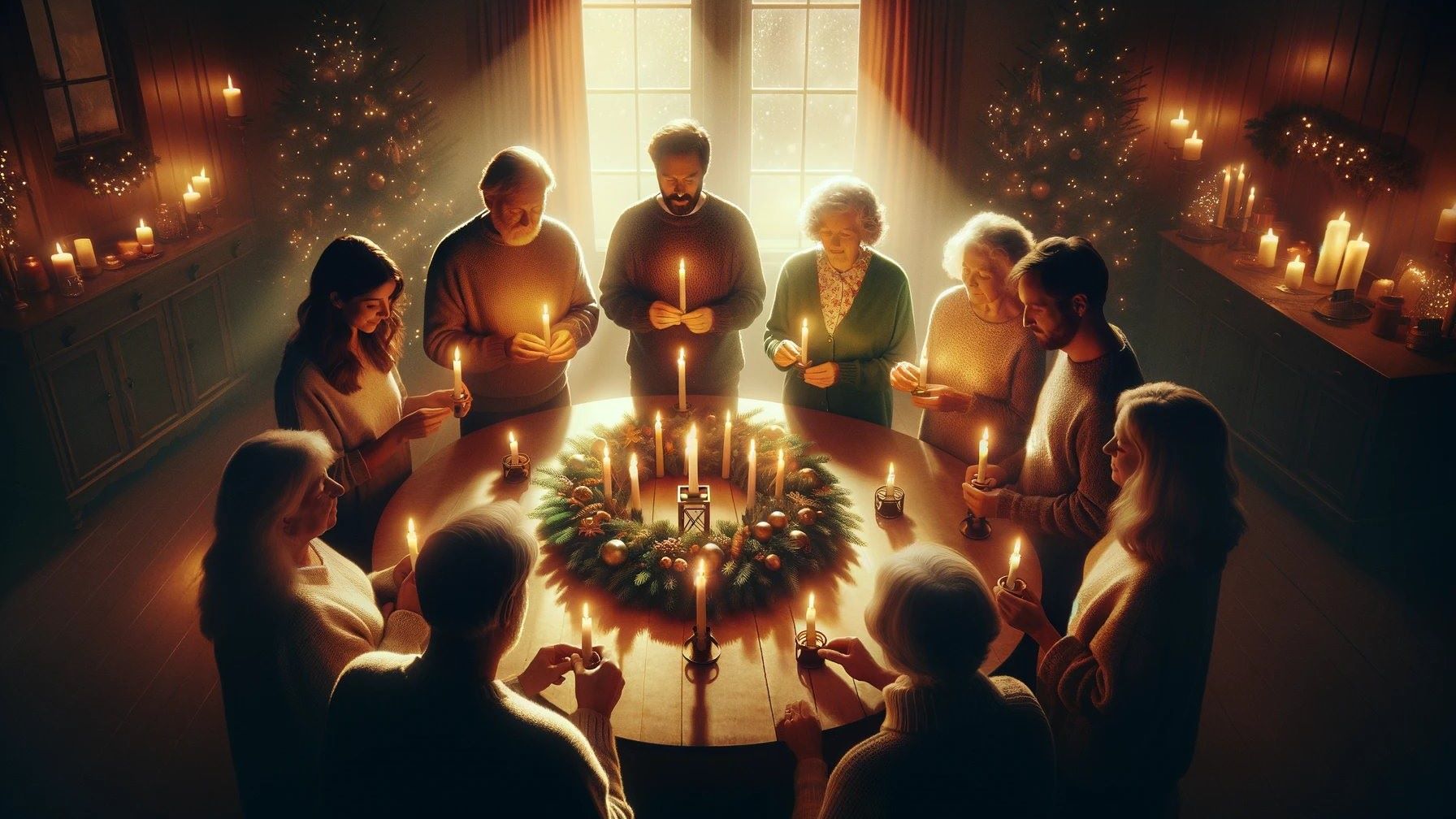Home>Special Themes>Why Is The Advent Candle Pink


Special Themes
Why Is The Advent Candle Pink
Published: February 13, 2024
Ericka Andersen, an editor at Christian.net, expertly merges digital strategy with content creation, focusing on faith and societal issues. Her communication skills enhance the platform's engaging narratives, fostering meaningful dialogue on belief's impact on society.
Discover the significance of the pink Advent candle and its special themes. Learn why it holds a unique place in the Advent season.
(Many of the links in this article redirect to a specific reviewed product. Your purchase of these products through affiliate links helps to generate commission for Christian.net, at no extra cost. Learn more)
Table of Contents
Introduction
Advent, a time of anticipation and preparation for the joyous celebration of Christmas, is marked by various traditions and symbols. One such symbol is the Advent wreath, adorned with four candles, each representing different aspects of the season. While three of the candles are traditionally purple, the fourth candle stands out in a vibrant shade of pink. This unique addition to the Advent wreath has sparked curiosity and intrigue, prompting many to wonder about its significance and meaning.
The pink candle, often lit on the third Sunday of Advent, holds a special place in the hearts of those who observe this tradition. Its presence adds a touch of warmth and joy to the solemnity of the Advent season, inviting contemplation and reflection on its deeper symbolism. Understanding the history and significance of the pink candle in the context of Advent can enrich our appreciation for this cherished tradition and deepen our spiritual connection to the season.
As we delve into the history and symbolism of the pink Advent candle, we will uncover the rich tapestry of traditions and beliefs that have shaped its role in the Advent wreath. From its origins to its modern-day significance, the pink candle carries a message of hope, joy, and anticipation, offering a beacon of light amidst the darkness of winter. Join us on this enlightening journey as we explore the captivating story behind the pink candle and its profound meaning within the context of the Advent season.
Read more: Why Pink And Purple Candles At Advent
The History of Advent Candles
The tradition of using candles to mark the Advent season dates back to the early 19th century in Germany. During this time, the dark and wintry days leading up to Christmas prompted the need for a visual representation of the anticipation and hope associated with the birth of Christ. This led to the creation of the Advent wreath, a circular arrangement of evergreen foliage adorned with candles.
Originally, the Advent wreath featured four red candles, symbolizing the four weeks of Advent. As the tradition evolved, the colors of the candles were later changed to three purple candles and one pink candle. The use of purple, a color associated with penance and preparation, reflects the solemnity and introspective nature of the Advent season. The pink candle, on the other hand, introduces a joyful and celebratory element into the Advent observance.
The symbolism of the candles is deeply rooted in Christian tradition, with each candle representing a different aspect of the spiritual journey towards Christmas. The first purple candle, often lit on the first Sunday of Advent, symbolizes hope. The second purple candle, lit on the following Sunday, represents love. The pink candle, lit on the third Sunday of Advent, signifies joy. Finally, the third purple candle, lit on the fourth Sunday, symbolizes peace.
The use of candles in the Advent wreath serves as a visual reminder of the passage of time and the gradual approach of Christmas. As each candle is lit in succession, the increasing light serves as a metaphor for the growing anticipation and hope associated with the birth of Christ. The pink candle, in particular, stands out as a beacon of joy amidst the solemnity, signaling a shift in focus from introspection to exuberant anticipation.
Over time, the tradition of the Advent wreath and its symbolic candles has spread beyond its German origins, becoming a cherished custom in Christian households and congregations around the world. The history of Advent candles is a testament to the enduring power of tradition and ritual in fostering a sense of community and spiritual connection during the Advent season.
The Symbolism of the Pink Candle
The pink candle in the Advent wreath holds profound symbolism, representing a significant shift in the tone and focus of the Advent season. As the third candle to be lit, typically on the third Sunday of Advent, the pink candle embodies the theme of joy. This joyful symbolism serves as a powerful reminder of the imminent arrival of the long-awaited celebration of Christmas.
Amidst the solemnity and introspection that characterize the early weeks of Advent, the appearance of the pink candle introduces a palpable sense of anticipation and rejoicing. Its vibrant hue stands out against the backdrop of the traditional purple candles, signaling a shift in emphasis from penance and preparation to joyful expectation.
The color pink, often associated with warmth, affection, and happiness, infuses the Advent observance with a sense of lightheartedness and optimism. It serves as a visual representation of the joy that permeates the hearts of believers as they eagerly await the commemoration of the birth of Christ.
The symbolism of the pink candle extends beyond its visual appeal, delving into the emotional and spiritual dimensions of the Advent season. It serves as a beacon of hope and encouragement, reminding individuals of the transformative power of joy in the midst of challenges and uncertainties.
Furthermore, the pink candle's placement in the Advent wreath, encircled by the preceding purple candles, underscores the progression of the Advent journey. It marks a pivotal moment in the season, inviting participants to shift their focus from introspection to exuberant anticipation.
The symbolism of the pink candle resonates deeply with the human experience, offering a message of resilience and optimism in the face of adversity. Its radiant glow serves as a testament to the enduring spirit of hope and the promise of a brighter tomorrow.
In essence, the pink candle in the Advent wreath symbolizes the profound joy that accompanies the anticipation of Christ's birth. Its presence serves as a poignant reminder of the transformative power of joy and the enduring hope that sustains believers as they journey through the Advent season.
As the pink candle is lit, its luminous glow illuminates the path towards Christmas, infusing the hearts of believers with a sense of exultation and jubilation. This symbolic gesture encapsulates the essence of the Advent season, inviting individuals to embrace the joy that emanates from the promise of redemption and renewal.
The Meaning of the Pink Candle in Advent Wreaths
The pink candle in the Advent wreath holds profound significance, serving as a focal point that embodies the essence of joy within the Advent season. As the third candle to be lit, typically on the third Sunday of Advent, the pink candle represents a pivotal juncture in the spiritual journey towards Christmas. Its distinctive color and placement within the Advent wreath convey a message of hope, anticipation, and celebration.
The Advent wreath, with its evergreen foliage and symbolic candles, serves as a visual representation of the passage of time and the gradual approach of Christmas. The inclusion of the pink candle introduces a notable shift in the tone of the Advent observance, transitioning from a period of introspection and preparation to one of joyful anticipation. This transition aligns with the overarching themes of the Advent season, marking a progression from penance to exultation.
The color pink, often associated with warmth, affection, and happiness, infuses the Advent wreath with a sense of lightheartedness and optimism. Its vibrant hue stands out against the backdrop of the traditional purple candles, symbolizing a departure from the solemnity of the preceding weeks. The pink candle's radiant glow serves as a beacon of joy, illuminating the path towards the imminent celebration of Christ's birth.
Furthermore, the placement of the pink candle within the Advent wreath holds symbolic significance. Encircled by the preceding purple candles, the pink candle occupies a central position, signifying a pivotal moment in the Advent journey. Its presence serves as a visual reminder of the transformative power of joy and the promise of redemption that lies at the heart of the Christmas narrative.
The lighting of the pink candle on the third Sunday of Advent marks a joyous milestone, inviting participants to embrace the exuberant anticipation of Christmas. Its luminous flame symbolizes the profound joy that accompanies the anticipation of Christ's birth, infusing the hearts of believers with a sense of exultation and jubilation. This symbolic gesture encapsulates the essence of the Advent season, inviting individuals to rejoice in the promise of redemption and renewal.
In essence, the pink candle in the Advent wreath embodies the spirit of joy that permeates the Advent season, serving as a poignant reminder of the transformative power of hope and anticipation. Its presence enriches the Advent observance, inviting participants to embrace the profound joy that emanates from the promise of Christ's imminent arrival.
The Significance of the Third Sunday of Advent
The third Sunday of Advent, also known as Gaudete Sunday, holds profound significance within the liturgical calendar and the observance of the Advent season. Gaudete, a Latin word meaning "rejoice," encapsulates the central theme of this pivotal juncture in the Advent journey. As the pink candle is ceremoniously lit on this day, it serves as a beacon of joy, illuminating the path towards the imminent celebration of Christ's birth.
Gaudete Sunday marks a distinct shift in the tone of the Advent season, transitioning from a period of solemn preparation to one of exuberant anticipation. The color pink, symbolizing joy, infuses the liturgy and rituals of this day with a palpable sense of celebration. It serves as a visual reminder of the profound joy that accompanies the anticipation of Christ's birth, inviting believers to rejoice in the promise of redemption and renewal.
The liturgical readings and prayers associated with Gaudete Sunday further emphasize the theme of rejoicing. The scriptures resonate with messages of hope, joy, and anticipation, underscoring the transformative power of the Christmas narrative. The traditional lighting of the pink candle within the Advent wreath serves as a symbolic gesture, inviting congregants to embrace the joyous anticipation of Christ's imminent arrival.
Beyond its symbolic significance, Gaudete Sunday holds a deeper spiritual meaning for believers. It serves as a poignant reminder of the enduring presence of joy amidst the challenges and uncertainties of life. The jubilant atmosphere of this day encourages individuals to reflect on the profound impact of joy in fostering resilience, gratitude, and a sense of communal celebration.
Gaudete Sunday also serves as a pivotal moment for introspection and spiritual renewal. As the Advent journey progresses, the emphasis on joy invites believers to rekindle their sense of hope and optimism, drawing inspiration from the promise of Christ's coming. It offers a moment of respite and encouragement, infusing the hearts of the faithful with a renewed sense of purpose and anticipation.
In essence, the significance of the third Sunday of Advent, embodied in Gaudete Sunday, lies in its ability to evoke a profound sense of joy and anticipation within the hearts of believers. It serves as a transformative milestone, inviting individuals to rejoice in the promise of redemption and renewal as they journey towards the celebration of Christ's birth. Gaudete Sunday stands as a testament to the enduring power of joy in illuminating the path towards spiritual fulfillment and communal celebration during the Advent season.
Conclusion
In conclusion, the pink candle in the Advent wreath represents a profound symbol of joy and anticipation within the Advent season. Its vibrant hue and placement within the wreath serve as a visual reminder of the transformative power of joy amidst the solemnity of the season. As the third candle to be lit, typically on the third Sunday of Advent, the pink candle marks a pivotal juncture in the spiritual journey towards Christmas, inviting participants to shift their focus from introspection to exuberant anticipation.
The history of Advent candles, rooted in the early 19th century in Germany, reflects the enduring tradition of using visual symbols to mark the passage of time and the anticipation of Christ's birth. The evolution of the Advent wreath, from featuring four red candles to the incorporation of purple and pink candles, underscores the rich tapestry of traditions and beliefs that have shaped the observance of Advent.
The symbolism of the pink candle extends beyond its visual appeal, delving into the emotional and spiritual dimensions of the Advent season. It serves as a beacon of hope and encouragement, reminding individuals of the transformative power of joy in the midst of challenges and uncertainties. The pink candle's radiant glow illuminates the path towards Christmas, infusing the hearts of believers with a sense of exultation and jubilation.
The significance of the third Sunday of Advent, embodied in Gaudete Sunday, further amplifies the theme of rejoicing and anticipation. This pivotal moment within the liturgical calendar invites believers to embrace the joyous anticipation of Christ's imminent arrival, fostering a sense of communal celebration and spiritual renewal.
In essence, the pink candle in the Advent wreath embodies the spirit of joy that permeates the Advent season, serving as a poignant reminder of the transformative power of hope and anticipation. Its presence enriches the Advent observance, inviting participants to embrace the profound joy that emanates from the promise of Christ's imminent arrival.
As the pink candle is ceremoniously lit on Gaudete Sunday, it serves as a beacon of joy, illuminating the path towards the imminent celebration of Christ's birth. This symbolic gesture encapsulates the essence of the Advent season, inviting individuals to rejoice in the promise of redemption and renewal.
In conclusion, the pink candle in the Advent wreath stands as a testament to the enduring power of joy in illuminating the path towards spiritual fulfillment and communal celebration during the Advent season.














